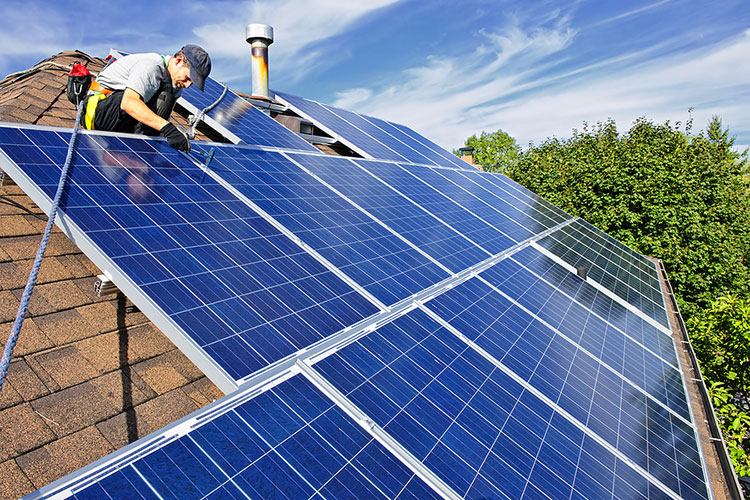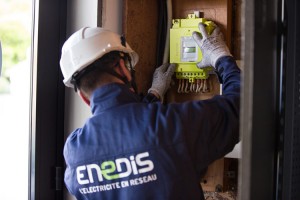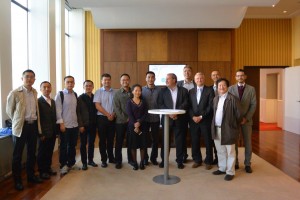[leap_dropcap style=”style-1″]T[/leap_dropcap]he ratification of the decree on microgrids was adopted last February. A photovoltaic tariff that should soon introduce an investment premium; packaged offers proposed by suppliers such as EDF and Engie: all the conditions are now met for the take-off of microgrids in France.
 Solar panels installed on a roof – Photo credit: Sun Tech in CC
Solar panels installed on a roof – Photo credit: Sun Tech in CC
Up to now, individuals installing solar panels on their roof (330 000 individuals according to EDF) had an interest in selling all the electricity they produced, since they benefited from a favourable tariff. Microgrids has long been marginal: only 15 000 individuals consumed their own production of electricity without selling the surplus to the grid. With lower feed-in tariffs, higher electricity prices and a drop in the cost of solar installations, half what it was a few years ago, economic conditions have become more favorable for microgrids.
[leap_gap height=”20px” ]
Microgrids are already recognised and subsidised in Germany, Italy and Belgium
In Germany, according to a report by the Ministry of the Environment “between January 2009 and March 2012, microgrids have benefited from a support mechanism that valued the share of self-produced production at different rates, for installations with less than 500 kWp, according to the rate of self-consumption (under or over 30%) “. Three billion kWh were thus domestically-consumed in 2013 produced by privately owned photovoltaic panels. In 2013, 6% of the German population produced part of its own electricity consumption.
[leap_gap height=”20px” ]
[leap_quote style=”single-quotes” bg_color=”” icon_size=”lg” icon_color=”” padding_right=”” padding_left=”” ]In 2013, 6% of the German population produced part of its own electricity consumption.[/leap_quote]
In Italy, “the support mechanism is based on a model of photovoltaic production installation coupled to a storage device and financed by a 50% tax deduction on material and installation costs”. In Belgium, the support system is currently based on the principle of net metering, which consists in deducting the amount of electricity injected into the grid from the quantity that is withdrawn for consumption. According to this system, the consumer pays only the residual part of the electricity withdrawn from the grid which has not been compensated by the quantity injected. “Net metering” has also been implemented in other European countries such as Denmark, some US states, Brazil and Australia.
“Some countries have put in place more innovative support mechanisms, such as Minnesota’s assessment and compensation mechanism for the “value of solar”. This approach aims to compare the overall gains for the community that can be got from solar generation to fossil fuel based production. The financial assistance granted to the producer is thus based on the addition of these various gains, estimated in dollars per kWh: saved environmental costs, costs related to the transport of the producible and its management, maintenance costs, etc. This system is still very controversial because of the difficulty of choosing the criteria for comparing costs and evaluating them.
[leap_gap height=”20px” ]
A regulatory and tax framework conducive to microgrids
The new regulatory framework which results from the ratification of two decrees of July and August 2016, was adopted on 15th February. This text lays the legal foundations for individual and collective microgrids in France. It provides for the establishment of specific tariffs for consumers participating in microgrids operations, when the power of the installation supplying them is less than 100 kW. In addition, it introduces an advantageous tax regime for small-scale producers operating installations with an installed capacity of less than 1 MW.
[leap_gap height=”20px” ]
[leap_quote style=”single-quotes” bg_color=”” icon_size=”lg” icon_color=”” padding_right=”” padding_left=”” ]This text lays the legal foundations for individual and collective microgrids in France.[/leap_quote]
A draft solar photovoltaic tariff for installations with a power of less than 100 kW is being prepared. It plans to introduce an investment bonus for microgrids facilities. Over five years, this premium would amount to 800 euros per kW for residential customers, ie 25 to 30% of the investment amount for a typical installation of 3 kW. Added to this is the systematic installation of the Linky communicating meter since 1 January 2017 for self-consumables with surplus injection, reducing the connection costs on average 600 euros HT.
[leap_gap height=”20px” ]
Commercial offers from suppliers
This autumn EDF ENR had anticipated the ratification of the ordinances with the launch of an offer dedicated to individuals: Mon soleil et moi (My sun and me). EDF panels will be manufactured “in France”, by Photowatt, and batteries, to optimize the rate of self-supply, by Korean manufacturer LG. On a fleet of some 14.5 million single-family houses, EDF hopes to convince 3,000 customers a year, which could correspond to a 10 MW photovoltaic installation per year.
[leap_gap height=”20px” ]
[leap_quote style=”single-quotes” bg_color=”” icon_size=”lg” icon_color=”” padding_right=”” padding_left=”” ]An Opinionway poll, conducted for the solar energy syndicate Enerplan, revealed that 47% of French people say they are ready to invest[/leap_quote]
For its part, since March 2017, Engie, has been offering the My Power device, for owners of single-family homes in the south of France with all-electric heating. Four million electrically heated single-family homes are, according to Engie, eligible for this offer. An Opinionway survey, conducted for the solar energy syndicate Enerplan, revealed that 47% of French people say they are ready to invest to convert. destiné aux propriétaires de maisons individuelles du sud de la France chauffées au tout-électrique. Quatre millions de maisons individuelles chauffées à l’électrique seraient, selon Engie, éligibles à cette offre. Un sondage Opinionway, réalisé pour le syndicat de l’énergie solaire Enerplan, révélait que 47 % des Français se disent prêts à investir pour s’y convertir.
[leap_gap height=”20px” ]
Microgrids tenders from the Ministry of the Environment
In August 2016, the Ministry of the Environment launched a call for tenders dedicated to the microgrids for installations from 100 to 500 kW located in mainland France. 72 projects were selected in November 2016 for a total power of 20.59 MW. These projects receive a premium at a adjusted price of 40.88 euros per MWh. The average self-supply rate of the winners of the call for tenders is 97.4%, reflecting a real desire to use its own electricity.
[leap_gap height=”20px” ]
[leap_quote style=”single-quotes” bg_color=”” icon_size=”lg” icon_color=”” padding_right=”” padding_left=”” ]A multi-year call for tenders for electricity production installations using renewable energy for self-supply at around 150 MW per year[/leap_quote]
The winners of the second period of the call for tenders were appointed on March 9, 2017. The 62 winners, represent a new volume of 20 MW. They will benefit from a premium at an adjusted price of 19.35 euros per MWh. More than two thirds of the photovoltaic modules resulting from this invitation to tender will be manufactured in France. The winners will produce 25 GWh per year and will generate investments of 27 million euros.
In order to sustain the economic model of microgrids, in March 2017, the Ministry of the Environment launched a multi-year call for tenders for electricity production facilities from using renewable energies for a volume of 150 MW. “This call for tenders aims to develop a new economic model in which industrial, tertiary and agricultural facilities produce and consume their own electricity locally. The first application period will close next September “.
ITEMS International for Think Smartgrids


